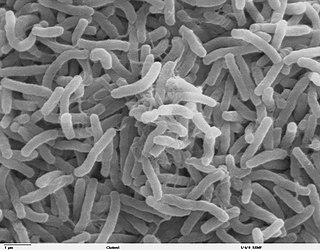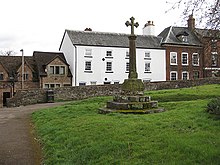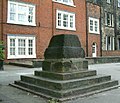
Daniel Defoe was an English journalist, merchant, pamphleteer and spy. He is most famous for his novel Robinson Crusoe, published in 1719, which is claimed to be second only to the Bible in its number of translations. He has been seen as one of the earliest proponents of the English novel, and helped to popularise the form in Britain with others such as Aphra Behn and Samuel Richardson. Defoe wrote many political tracts, was often in trouble with the authorities, and spent a period in prison. Intellectuals and political leaders paid attention to his fresh ideas and sometimes consulted him.

The Great Plague of London, lasting from 1665 to 1666, was the last major epidemic of the bubonic plague to occur in England. It happened within the centuries-long Second Pandemic, a period of intermittent bubonic plague epidemics that originated in Central Asia in 1331, and included related diseases such as pneumonic plague and septicemic plague, which lasted until 1750.

Samuel Pepys was an English diarist and naval administrator. He served as administrator of the Royal Navy and Member of Parliament and is most famous for the diary he kept for a decade. Pepys had no maritime experience, but he rose to be the Chief Secretary to the Admiralty under both King Charles II and King James II through patronage, diligence, and his talent for administration. His influence and reforms at the Admiralty were important in the early professionalisation of the Royal Navy.

Ursula Southeil, popularly known as Mother Shipton, was an English soothsayer and prophetess according to English folklore.

The germ theory of disease is the currently accepted scientific theory for many diseases. It states that microorganisms known as pathogens or "germs" can cause disease. These small organisms, too small to be seen without magnification, invade humans, other animals, and other living hosts. Their growth and reproduction within their hosts can cause disease. "Germ" refers to not just a bacterium but to any type of microorganism, such as protists or fungi, or even non-living pathogens that can cause disease, such as viruses, prions, or viroids. Diseases caused by pathogens are called infectious diseases. Even when a pathogen is the principal cause of a disease, environmental and hereditary factors often influence the severity of the disease, and whether a potential host individual becomes infected when exposed to the pathogen. Pathogens are disease-carrying agents that can pass from one individual to another, both in humans and animals. Infectious diseases are caused by biological agents such as pathogenic microorganisms as well as parasites.

Eyam is an English village and civil parish in the Derbyshire Dales that lies within the Peak District National Park. There is evidence of early occupation by Ancient Britons on the surrounding moors and lead was mined in the area by the Romans. A settlement was founded on the present site by Anglo-Saxons, when mining was continued and other industries later developed. However, Eyam’s main claim to fame is the story of how the village chose to go into isolation so as to prevent infection spreading after bubonic plague was discovered there in 1665.

During the Great Plague of 1665 the area of Derby, England, fell victim to the bubonic plague epidemic, with many deaths. Some areas of Derby still carry names that record the 1665 visitation such as Blagreaves Lane which was Black Graves Lane, while Dead Man's Lane speaks for itself. It has been claimed by some historians that bodies were buried standing upright at St. Peter's Church, Derby, but this legend has been refuted by experts.

A cordon sanitaire is the restriction of movement of people into or out of a defined geographic area, such as a community, region, or country. The term originally denoted a barrier used to stop the spread of infectious diseases. The term is also often used metaphorically, in English, to refer to attempts to prevent the spread of an ideology deemed unwanted or dangerous, such as the containment policy adopted by George F. Kennan against the Soviet Union.

The Great Plague of Vienna occurred in 1679 in Vienna, Austria, the imperial residence of the Austrian Habsburg rulers. From contemporary descriptions, the disease is believed to have been bubonic plague, which is caused by the bacterium Yersinia pestis, carried by fleas associated with the black rat and other rodents. The city was crippled by the epidemic, which recurred fitfully into the early 1680s, claiming an estimated 76,000 residents.

Wentworth is a village and civil parish in the Metropolitan Borough of Rotherham in South Yorkshire, England.

The Great Plague of Marseille, also known as the Plague of Provence, was the last major outbreak of bubonic plague in Western Europe. Arriving in Marseille, France, in 1720, the disease killed over 100,000 people: 50,000 in the city during the next two years and another 50,000 to the north in surrounding provinces and towns.

Brugherio is a comune (municipality) in the Province of Monza and Brianza in the Italian region Lombardy, located about 10 kilometres northeast of Milan. It was established December 9, 1866 unifying the suppressed municipalities of Baraggia, San Damiano and Moncucco, together with the villages of Bindellera, Cesena, Gelosa, San Paolo, Torazza, Occhiate and Increa.

Loimologia, or, an historical Account of the Plague in London in 1665, With precautionary Directions against the like Contagion is a treatise by Dr. Nathaniel Hodges (1629–1688), originally published in London in Latin in 1672; an English translation was later published in London in 1720. The treatise provides a first-hand account of the Great Plague of London; it has been described as the best medical record of the epidemic.

The Great Fire of London was a major conflagration that swept through central London from Sunday 2 September to Thursday 6 September 1666, gutting the medieval City of London inside the old Roman city wall, while also extending past the wall to the west. The death toll is generally thought to have been relatively small, although some historians have challenged this belief.

William Mompesson was a Church of England priest whose decisive action when his Derbyshire parish, Eyam, became infected with the plague in the 17th century averted more widespread catastrophe.

The Black Death was a bubonic plague pandemic, which reached England in June 1348. It was the first and most severe manifestation of the second pandemic, caused by Yersinia pestis bacteria. The term Black Death was not used until the late 17th century.

There are three plague crosses in Brugherio, in the province of Monza and Brianza in Lombardy, in northern Italy. They were erected after the plague that struck Monza and its surrounding area in 1576. The crosses are three that remain of four that marked where there were four altars used to celebrate religious services during the plague. The plague of 1576 was in fact called "the plague of Saint Charles", given the Bishop's closeness to those affected. Information about the plague can be found in the Bishop of Milan, Saint Charles Borromeo's notes.

San Carlo is a church located in Via Piergiorgio Frassati, in the west of Brugherio and it is part of the pastoral community Epiphany of the Lord.

In 1563, London experienced its worst episode of plague during the sixteenth century. At least 20,136 people in London and surrounding parishes were recorded to have died of plague during the outbreak. Around 24% of London's population ultimately perished, but the plague affected London's unsanitary parishes and neighbourhoods the most.

The 1813–1814 Malta plague epidemic was the last major outbreak of plague on the islands of Malta and Gozo. It occurred between March 1813 and January 1814 on Malta and between February and May 1814 on Gozo, and the epidemic was officially declared to be over in September 1814. It resulted in approximately 4500 deaths, which was about 5% of the islands' population.



























